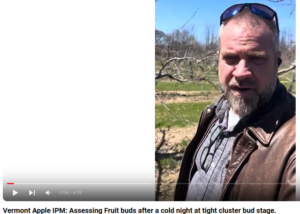Jim Wargo from Valent U.S.A. passed these recommendations on for growers considering using Promalin on frost-affected trees. These make horticultural sense to me, and Jim highlights the limitations well. -TB
Promalin: What to do when freeze events occur at tight cluster to pink
Apples at tight cluster to early pink are more tolerant to cold temperatures than fully open flowers. Nonetheless, if the temperatures do get cold enough (27/28F), injury to flower reproductive parts can occur. I often get asked this time of year “will Promalin help set fruit after a damaging frost event at tight cluster to pink”. The short answer is yes, but there is a caveat. Don’t run out the next day and spray Promalin as if the trees were in full bloom. Be patient and follow the series of steps below.
Guidance on Promalin use when damaging frost occurs before the bloom stage:
- Do not apply Promalin the next day after a frost event during tight cluster and early pink growth stages: You will be underwhelmed by the results if you do. If trees are at full pink (all five unfurled flowers fully extended) then wait until the first few king flowers open
- Assess flower buds for cold injury at tight cluster to pink: Do this by dissecting flowers that have not yet fully opened to see if the reproductive flower parts are still alive. If you see brown discoloration inside the developing flower, then it means the female part of the flower (pistol) is dead and no pollination or fertilization will occur. The tree will subsequently shed those flowers. Note: In many cases the flowers will open and look fine (no injury to the petals), but that can be deceiving. Make sure to inspect the flower reproductive parts closely as previously mentioned.
- Determine the injury threshold: It’s up to you to determine if there are enough damaged flowers on the trees that may result in reduced fruit set and crop loss. Remember, you don’t need every flower to set. In most cases, the goal is for only one of the five flowers on a spur to develop in to a fruit. It’s also important to have an adequate number of non-fruiting spurs for next year’s crop. Don’t panic if there is modest flower injury. Consider it your first thinning application…
- Decide: If your damage assessment suggests that crop loss is likely then you can make the choice to spay Promalin on the trees to increase fruit set. Apply one pint of Promalin/Acre, timing the application to first flower/early bloom stage . Applications made later than early flowering have been shown to be ineffective in situations where flower injury occurred from freeze events at tight cluster through pink. Use sufficient water volume ~100 gal/Acre to ensure good coverage and apply under slow drying conditions if at all possible.
It’s important to understand how Promalin works and what its limitations are. While I will not go in to all the details in this article, I want to underscore a few key points
- Promalin IS NOT an anti-freeze type product. It will not lower the freezing point of the plant tissue if applied ahead of a frost event
- Promalin WILL NOT revive, resuscitate or repair plant/flower tissue that is damaged by freezing temperatures
- Promalin is basically equivalent to hormone replacement therapy in humans. In the normal pollination process, fertilized ovules begin to develop in to seeds that produce hormones including cytokinins and gibberellins. These hormonal signals tell the tree there is viable seed in the apple. The seed is essentially the offspring, and the tree will continue to nourish the developing seed with carbohydrates and nutrients. However, if fertilization does not happen due to reproductive flower injury or poor pollination weather, then no viable seed will develop. In that scenario, the tree is much more likely to shed the fruit and put it’s energy in to those apples that have the potential to produce progeny. That’s where Promalin comes in. Promalin applied to sterile flowers provides the hormonal signal that would normally come from the developing seed. That’s why it’s important to synchronize the application of Promalin with the trees natural phenology – slightly ahead of or during the early pollination window. Trees don’t receive hormonal signals from developing seeds from tight cluster through pink, so why apply Promalin then? The cytokinin and gibberellins will be long gone by the time bloom comes around. Coincide the application to the same stage the tree is expecting to receive those signals instead. The fruit that develops after Promalin application will have low seed count or no seeds at all, but it will develop to normal size as research studies have shown.
Note on Pears:
There was some confusion abut Promalin being labeled for fruit set on pears. The issue is that both CDMS and Agrian had outdated labels that did not include this use pattern. The Promalin label was updated a few years ago and now allows use on pears for fruit set. It can be used on pears to set fruit in the absence of frost. See below for guidance.




